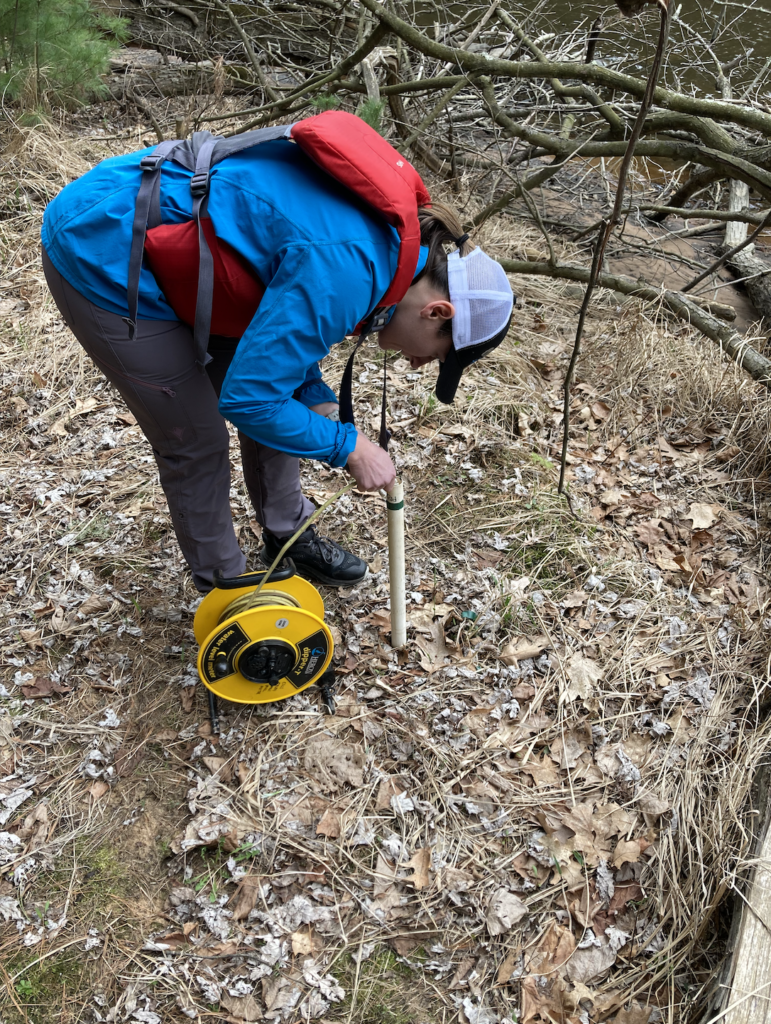There is an invisible world beneath your feet. It stretches from the dark, sun-warmed topsoil where plants wet their roots, to layers of loose sediment and solid rock where water flows between fine grains and cracks. This subterranean world is what hydrogeologists at the Wisconsin Geological and Natural History Survey (WGNHS) explore. And it’s worth becoming familiar with, because it is where most of our drinking water comes from.
WGNHS has a team of hydrogeologists who help ensure that groundwater, the water beneath the land surface, is a safe and sustainable drinking water supply. Hydrogeologist Amy Wiersma is one of the team members. She explains that about 70% of Wisconsin residents receive their drinking water from groundwater.
“What really drew me into hydrogeology was learning about how abundant groundwater is compared to surface water. It’s going to be such an important resource to know how to manage properly [in the future],” Wiersma said.
According to the US Geological Survey, groundwater accounts for 30% of all the freshwater on Earth, which is a lot considering another 68.7% is locked up in glaciers and ice. For comparison, surface freshwater from lakes and rivers only makes up 1.2% of all freshwater.

To understand how Wisconsin’s water and geology interact, hydrogeologists ask questions about how groundwater flows, how fast it moves, and how it interacts with rocks and soil, Wiersma explains. They also ask questions about links between groundwater and surface water, which are well-connected in Wisconsin.
The questions are followed by a series of field surveys, sample collection, and lab or modeling experiments. Wisconsin is very geologically diverse, having sediments and rocks with different physical properties that impact how groundwater moves through them, Wiersma says.
In her role, Wiersma works closely with Wisconsin’s local and county governments to map out their groundwater supply, including areas where groundwater is vulnerable to contamination from the land surface. Generally, the quality of groundwater depends on both the physical properties of the landscape and the land use practices above it.
For example, Wiersma and WGNHS colleagues are currently conducting an inventory of groundwater resources in Burnett County, including an evaluation of private residential wells. The project is a collaborative effort with the Burnett County Conservation Division and Land Services Department, the St Croix Chippewa Environmental and Natural Resources Department, and the Center for Watershed Science and Education Water & Environmental Analysis Lab (WEAL) at the University of Wisconsin-Stevens Point.
Wiersma uses the inventory to generate a map to identify regions in the county where the landscape is most susceptible to changes in groundwater quality, at a time when the county anticipates increases in land conversion to agricultural use. The results can be used for future groundwater management strategies and public education.
Education is especially important, because there are many misconceptions about groundwater. Wiersma says that people often mistake groundwater for being a cavernous, underground river, when it is actually fine individual molecules of water moving between grains of sediment and rock. The water travels into the ground after being dropped from the sky as precipitation, Wiersma explains.
Many of WGNHS’s hydrogeologists work closely with community interests throughout the state. For Wiersma, seeing the effect of her hydrogeology research in the community is especially rewarding.
“My favorite part is just how applied the work is. It really does have an impact on the residents of Wisconsin because it is such an important resource in our state for drinking water,” Wiersma says.
If you’re located in Wisconsin, there’s a high likelihood that your drinking water is coming from beneath your feet, and a hydrogeologist from WGNHS is continuing to ensure your supply stays healthy.




